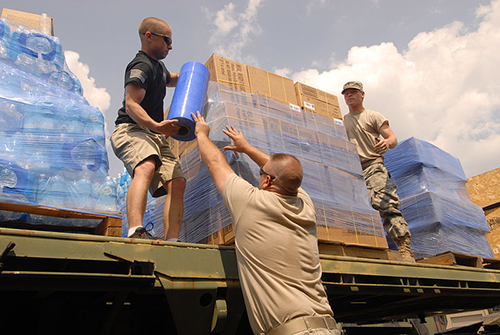Aug 28 2015 The Ohio Public Private Partnership’s new credentialing system aims to hasten delivery of supplies to disaster areas
 National Preparedness Month begins in just a few days, and with its four weekly themes of floods, wildfires, hurricanes, and power outages, it reminds us of the ways disasters can affect our communities — and when they do, help is needed fast. During and after disasters, residents may become stranded, rendering them unable to obtain critical medication and supplies. In these cases, supplies must be brought in to the restricted areas, and law enforcement officers must check the credentials of the individuals bringing the supplies. But the clearance verification process can slow the delivery of these essentials, points out John Born, Director of the Ohio Department of Public Safety. “You don’t want that to get clogged at a checkpoint because of some questions of whether or not someone should have access.”
National Preparedness Month begins in just a few days, and with its four weekly themes of floods, wildfires, hurricanes, and power outages, it reminds us of the ways disasters can affect our communities — and when they do, help is needed fast. During and after disasters, residents may become stranded, rendering them unable to obtain critical medication and supplies. In these cases, supplies must be brought in to the restricted areas, and law enforcement officers must check the credentials of the individuals bringing the supplies. But the clearance verification process can slow the delivery of these essentials, points out John Born, Director of the Ohio Department of Public Safety. “You don’t want that to get clogged at a checkpoint because of some questions of whether or not someone should have access.”
The recently proposed Emergency Partner Credentialing System is a tool for securely speeding up the entry of private sector partners with supplies into disaster areas. The system is part of the Ohio Public Private Partnership (OP3), an intersector initiative formed in 2013 to improve disaster response, now comprising 175 businesses, government agencies, colleges, and associations. For more on the OP3, check out The Intersector Project’s previous article on this collaboration.
The OP3’s credentialing system will allow private partners to receive free credentials from Ohio Homeland Security, which will be stored in a shared database accessible to the law enforcement officers controlling access to disaster areas. This database will enable officers to quickly verify the credentials of individuals associated with these partners, leveraging OP3’s partnerships to more easily provide medications, water, and other crucial supplies to residents who are stranded in disaster areas. According to Born, some partners will receive the credentials for specific locations and events, while others, such as utility workers, will receive credentials allowing entrance in the event of multiple disasters. Ohio is currently recruiting private sector participants and plans to have the system in place by early 2016.
Key stakeholders recently discussed the credentialing system at the inaugural Northern Region Conference for the Ohio Public Private Partnership (OP3) program, hosted by the Ohio Department of Public Safety. Leaders in public safety, emergency preparedness, emergency management, and business continuity/disaster recovery convened to gather input and share best practices among partners. According to Born, a participant at an event similar to this regional planning conference suggested the idea for the credentialing system last year, and technology staff developed the credentialing system for the state of Ohio.
Each sector brings unique resources and assets to the OP3. The private sector has essential supplies, but the public sector has the ability to implement their dissemination when they are most needed. The convergence of leaders from the private and public sectors at the recent regional planning conference demonstrates their recognition that a continuing dialogue about the reliance between the sectors is an important aspect of their work. The continuing work of the OP3 contributes to cross-sector understanding as the partners continue to learn about each other’s resources, operational needs, and capabilities.
